字符输入输出和字符确认
输入和输出函数的区别

输入输出函数区别如下:一、printf 、sprintf、fprintf的区别1.1 都是把格式好的字符串输出,只是输出的目标不一样:1)、printf,是把格式字符串输出到标准输出(一般是屏幕、控制台,可以重定向),是和标准输出文件(stdout)关联的;原型为: int printf(const char *format[,argument]...);2)、sprintf,是把格式字符串输出到指定的字符串中,所以参数比printf多一个char*。
这是目标字符串地址;原型为:int sprintf(char *buffer,const char *format[,argument]...);3)、fprintf,是把格式字符串输出到指定文件设备中,fprintf是格式化输出到一个stream,通常是到文件,所以参数比printf多一个文件指针FILE*;原型为:int fprintf(FILE *stream,const char *format[,argument]...);1.2. Fprintfc语言把文件看作一个字符(字节)的序列,即由一个一个字符(字节)的数据顺序组成。
根据数据的组成形式,可分为ASCLL文件和二进制文件。
ASCLL文件又称为文本文件(text),它的每个字节放一个ASCLL代码,代表一个字符。
二进制文件是内存中的数据按其在内在中的存储形式原样输出到磁盘上存放。
1).fprintf(fp,"%d",buffer);是将格式化的数据写入文件;fprintf(文件指针,格式字符串,输出表列);fwrite(&buffer,sizeof(int),1,fp); 是以二进位方式写入文件fwrite(数据,数据类型大小(字节数),写入数据的最大数据,文件指针); 由于fprintf写入是,对于整数来说,一位站一个字节,比如1,占1个字节;10,占2个字节;100,占3个字节;10000,占5个字节;所以文件的大小会随数据的大小而改变,对大数据空间占用很大。
字符及字符串输入输出与顺序程序设计实验报告
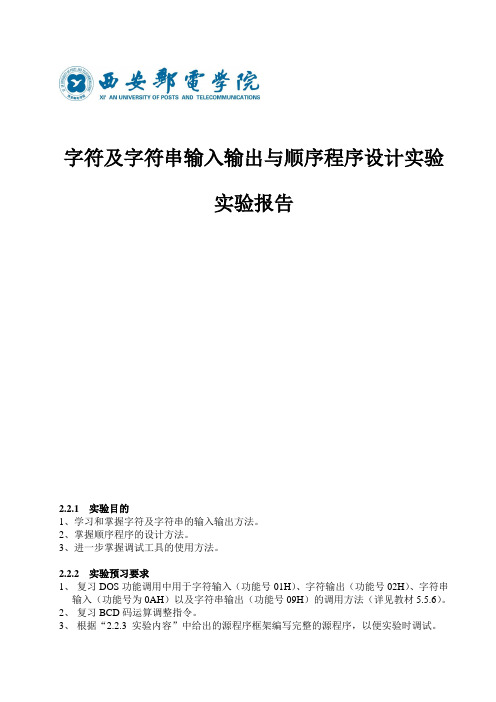
字符及字符串输入输出与顺序程序设计实验实验报告2.2.1 实验目的1、学习和掌握字符及字符串的输入输出方法。
2、掌握顺序程序的设计方法。
3、进一步掌握调试工具的使用方法。
2.2.2 实验预习要求1、复习DOS功能调用中用于字符输入(功能号01H)、字符输出(功能号02H)、字符串输入(功能号为0AH)以及字符串输出(功能号09H)的调用方法(详见教材5.5.6)。
2、复习BCD码运算调整指令。
3、根据“2.2.3 实验内容”中给出的源程序框架编写完整的源程序,以便实验时调试。
4、从“2.2.4 实验习题”中任选一道题目,编写源程序,以便上机调试。
2.2.3实验内容从键盘输入两个一位十进制数,计算这两个数之和,并将结果在屏幕上显示出来。
1、问题分析比如使用功能号为01H的用于实现单个字符输入的DOS功能调用接收从键盘输入的两个十进制数8和6,这时计算机内部得到的是这两个数的ASCII码值38H和36H。
由于数字0 9的ASCII码值与其代表的数值之间相差30H,因此将其减去30H即可得到以非压缩型BCD数形式表示的十进制数08H和06H,使用ADD指令对它们进行相加后结果为0EH(00001110B),显然需要用非压缩型BCD数加法调整指令对ADD的运算结果进行调整,调整后得到两个非压缩型BCD数01H和04H,将它们分别加上30H后变为其对应的ASCII码31H(1的ASCII码)和34H(4的ASCII码),然后调用功能号为02H用于单个字符输出的DOS功能调用将它们显示出来。
综上所述,需要考虑以下问题。
(1)从键盘输入一个一位十进制数的方法通过功能号为1的DOS功能调用实现从键盘输入一个字符,格式如下:MOV AH, 01HINT 21H ;此时程序等待用户键入,键入字符的ASCII码值存在AL中SUB AL, 30H ;减去30H后得到键入数字所代表的数值(2)提示信息字符串的显示通过功能号为9的DOS功能调用实现字符串显示,注意字符串的最后一个字符必需为’$’。
C语言基本类型字符型(char)用法介绍
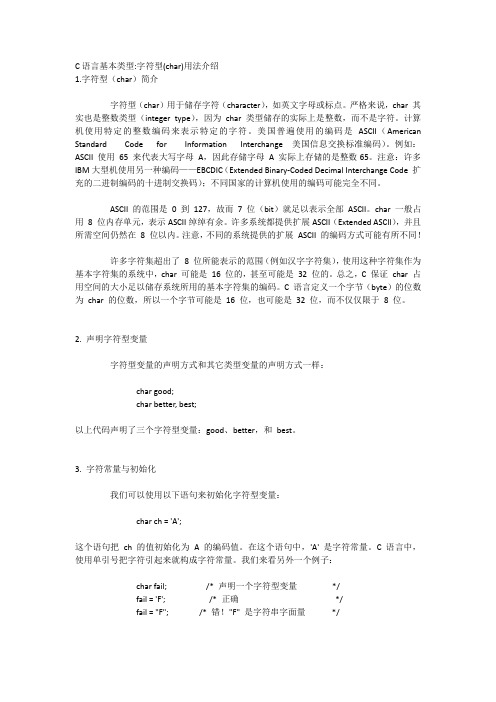
C语言基本类型:字符型(char)用法介绍1.字符型(char)简介字符型(char)用于储存字符(character),如英文字母或标点。
严格来说,char 其实也是整数类型(integer type),因为char 类型储存的实际上是整数,而不是字符。
计算机使用特定的整数编码来表示特定的字符。
美国普遍使用的编码是ASCII(American Standard Code for Information Interchange 美国信息交换标准编码)。
例如:ASCII 使用65 来代表大写字母A,因此存储字母A 实际上存储的是整数65。
注意:许多IBM大型机使用另一种编码——EBCDIC(Extended Binary-Coded Decimal Interchange Code 扩充的二进制编码的十进制交换码);不同国家的计算机使用的编码可能完全不同。
ASCII 的范围是0 到127,故而7 位(bit)就足以表示全部ASCII。
char 一般占用8 位内存单元,表示ASCII绰绰有余。
许多系统都提供扩展ASCII(Extended ASCII),并且所需空间仍然在8 位以内。
注意,不同的系统提供的扩展ASCII 的编码方式可能有所不同!许多字符集超出了8 位所能表示的范围(例如汉字字符集),使用这种字符集作为基本字符集的系统中,char 可能是16 位的,甚至可能是32 位的。
总之,C 保证char 占用空间的大小足以储存系统所用的基本字符集的编码。
C 语言定义一个字节(byte)的位数为char 的位数,所以一个字节可能是16 位,也可能是32 位,而不仅仅限于8 位。
2. 声明字符型变量字符型变量的声明方式和其它类型变量的声明方式一样:char good;char better, best;以上代码声明了三个字符型变量:good、better,和best。
3. 字符常量与初始化我们可以使用以下语句来初始化字符型变量:charch = 'A';这个语句把ch的值初始化为A 的编码值。
C语言复习题(考研版)
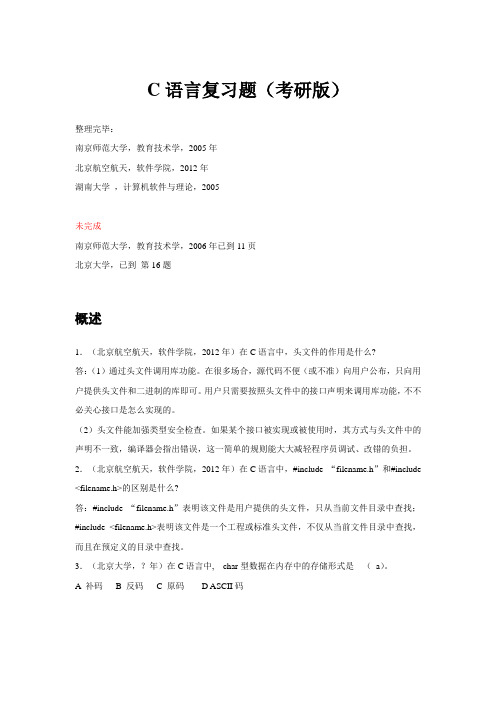
C语言复习题(考研版)整理完毕:南京师范大学,教育技术学,2005年北京航空航天,软件学院,2012年湖南大学,计算机软件与理论,2005未完成南京师范大学,教育技术学,2006年已到11页北京大学,已到第16题概述1.(北京航空航天,软件学院,2012年)在C语言中,头文件的作用是什么?答:(1)通过头文件调用库功能。
在很多场合,源代码不便(或不准)向用户公布,只向用户提供头文件和二进制的库即可。
用户只需要按照头文件中的接口声明来调用库功能,不不必关心接口是怎么实现的。
(2)头文件能加强类型安全检查。
如果某个接口被实现或被使用时,其方式与头文件中的声明不一致,编译器会指出错误,这一简单的规则能大大减轻程序员调试、改错的负担。
2.(北京航空航天,软件学院,2012年)在C语言中,#include “filename.h”和#include <filename.h>的区别是什么?答:#include “filename.h”表明该文件是用户提供的头文件,只从当前文件目录中查找;#include <filename.h>表明该文件是一个工程或标准头文件,不仅从当前文件目录中查找,而且在预定义的目录中查找。
3.(北京大学,?年)在C语言中, char型数据在内存中的存储形式是(a)。
A 补码B 反码C 原码D ASCII码标识符1.(北京航空航天,软件学院,2012年)在C语言中,标识符只能由字母、数字和下划线三种字符组成,并且第一个字符( C )。
A.必须是字母B.必须是下划线C.必须是字母或者下划线D.可以是字母、数字和下划线之一数据类型与表达式1.(南京师范大学,教育技术学,2006年)C语言中,宏定义#define PI 3.14159中,用宏名PI代替了一个(C )A 单精度数B 双精度数C 常量D 字符序列2.(北京大学,?年)C语言中最简单的数据类型包括( B )。
中文打字机工作原理
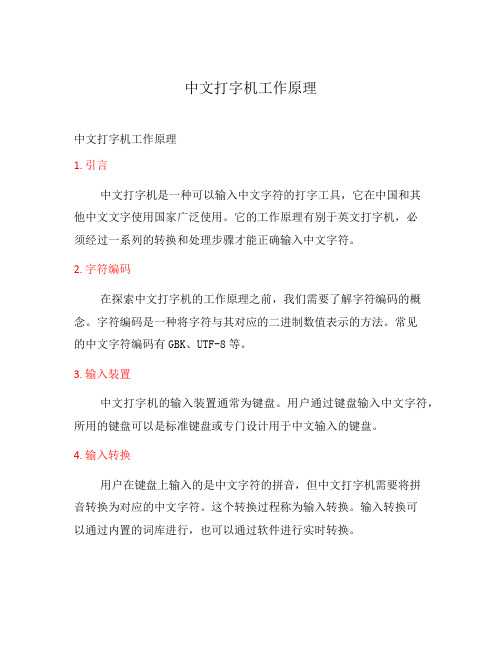
中文打字机工作原理中文打字机工作原理1. 引言中文打字机是一种可以输入中文字符的打字工具,它在中国和其他中文文字使用国家广泛使用。
它的工作原理有别于英文打字机,必须经过一系列的转换和处理步骤才能正确输入中文字符。
2. 字符编码在探索中文打字机的工作原理之前,我们需要了解字符编码的概念。
字符编码是一种将字符与其对应的二进制数值表示的方法。
常见的中文字符编码有GBK、UTF-8等。
3. 输入装置中文打字机的输入装置通常为键盘。
用户通过键盘输入中文字符,所用的键盘可以是标准键盘或专门设计用于中文输入的键盘。
4. 输入转换用户在键盘上输入的是中文字符的拼音,但中文打字机需要将拼音转换为对应的中文字符。
这个转换过程称为输入转换。
输入转换可以通过内置的词库进行,也可以通过软件进行实时转换。
5. 中英文切换除了输入转换外,中文打字机还需要提供中英文切换的功能。
当用户需要输入英文时,中文打字机会自动切换到英文模式,以便准确地输入英文字母。
6. 字符显示中文打字机通常具备屏幕显示功能,用于显示用户输入的字符和其他相关信息。
通过屏幕显示,用户可以实时查看自己所输入的拼音或中文字符。
7. 输出装置中文打字机的输出装置通常为打印机。
用户输入的中文字符会被发送到打印机中,打印机会根据字符编码打印出相应的中文字符。
8. 打印机字库中文打字机的打印机字库存储了各种中文字符的字形和对应的二进制编码。
在进行打印时,打印机会根据字符编码从字库中获取对应的字形,并将其打印到纸张上。
9. 打印机控制中文打字机的打印机控制模块负责向打印机发送打印指令,并控制打印机进行相应的操作,如移动打印头、控制纸张进纸等。
10. 输出处理中文打字机的输出还涉及到一系列的处理步骤,如字符格式化、对齐、页码控制等。
这些处理步骤保证了输出结果的规范和美观。
11. 结束语通过以上的列举和介绍,我们对中文打字机的工作原理有了初步的了解。
从用户输入开始,经过输入转换、中英文切换、字符显示、输出装置、打印机字库、打印机控制和输出处理等多个环节,最终完成打印的过程。
c语言字符串方法

c语言字符串方法C语言字符串方法在C语言中,字符串是一种常见的数据类型,用于存储和操作一串字符。
在本文中,我们将介绍一些常用的C语言字符串方法,包括字符串输入输出、字符串连接、字符串比较、字符串长度等。
1. 字符串输入输出C语言提供了多种方法用于输入和输出字符串。
其中,最常用的是使用printf和scanf函数。
printf函数用于将字符串输出到屏幕上,语法如下:```cprintf("字符串");```例如,下面的代码将输出"Hello World!"到屏幕上:```cprintf("Hello World!");```scanf函数用于从用户输入中读取字符串,语法如下:```cscanf("%s", 字符串变量);```例如,下面的代码将从用户输入中读取一个字符串,并将其存储到变量name中:```cchar name[100];scanf("%s", name);```2. 字符串连接在C语言中,我们可以使用strcat函数将两个字符串连接起来。
strcat函数的语法如下:```cstrcat(目标字符串, 要连接的字符串);```其中,目标字符串是要连接的两个字符串中的一个。
例如,下面的代码将把字符串"Hello"和字符串"World"连接起来,并将结果存储在变量str中:```cchar str[100] = "Hello";strcat(str, "World");```3. 字符串比较C语言提供了strcmp函数用于比较两个字符串。
strcmp函数的语法如下:```cstrcmp(字符串1, 字符串2);```如果两个字符串相等,strcmp函数返回0;如果字符串1小于字符串2,返回一个负数;如果字符串1大于字符串2,返回一个正数。
C语言的格式化输入输出
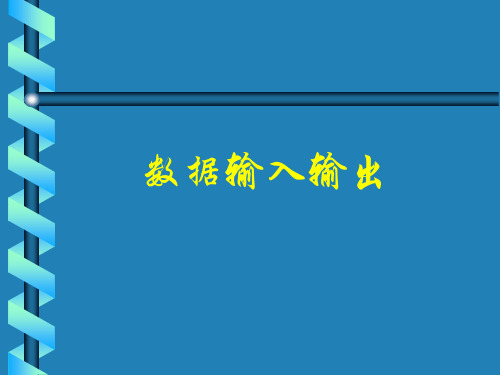
字符数组中,在输入时以非空白字符
s
开始,以第一种空白字符结束。字符
串以串结束标志'\0'作为最终一种字
符。
• 用来输入实数,能够用小数形式或指
Eg212.c
main( ) {
int a,b,c; scanf("%d%d%d",&a,&b,&c); printf("a=%d,b=%d,c=%d\n",a,b,c); printf("a+b+c=%d",a+b+c); }
注意:格式控制符旳个数与背面旳参数个数应 相等,且前后位置要一一相应。
Eg210.c Eg211.c
3、一般字符串与格式控制符混合使用
格式控制符用背面相应位置旳常量、 变量或体现式旳值替代,其他一般字符 一律原样显示。
main( ) {
printf("2+3=%d, 2*3=%d\n",2+3,2*3); }
格式化输入输出函数 printf( )/scanf( )
字符输入输出函数
getchar( )/putchar( )
getchar( )和putchar( )是一对用于单 个字符输入输出旳原则函数。
一、putchar( )函数
功能:在终端旳目前位置输出一种字符
格式:putchar(字符变量) 或 putchar('输出字符')
在程序开始用命令行#include <stdio.h> 把要使用旳信息包括到顾客程序中。
因为printf和scanf函数使用频繁, 系统允许使用时不加#include命令。
C语言旳函数库中有一批“原则 输入输出函数”,它们以原则旳输入 输出设备为输入输出对象。
C语言字符串处理掌握字符串的输入输出和处理函数

C语言字符串处理掌握字符串的输入输出和处理函数C语言字符串处理:掌握字符串的输入输出和处理函数在C语言中,处理字符串是十分重要的。
字符串是一系列字符的集合,在程序中广泛应用于文本处理和数据操作。
掌握字符串的输入输出和处理函数对于编写高效的C语言程序至关重要。
本文将介绍C语言中字符串的输入输出和一些常用的字符串处理函数。
一、字符串的输入输出1. 字符串的输入在C语言中,我们可以使用scanf函数来读取字符串的输入。
需要注意的是,由于scanf遇到空格、制表符或换行符时会停止读取,因此无法直接读取带有空格的字符串。
为了读取完整的字符串,我们可以使用fgets函数。
```c#include <stdio.h>int main() {char str[100];printf("请输入一个字符串:");fgets(str, sizeof(str), stdin);printf("您输入的字符串是:%s\n", str);return 0;}```上述代码中,我们定义了一个大小为100的字符数组str,并使用fgets函数从标准输入读取字符串。
其中sizeof(str)用于指定最大读取的字符数。
2. 字符串的输出在C语言中,我们可以使用printf函数来输出字符串。
需要注意的是,如果字符串中包含格式控制符(如%),需要使用转义字符%来表示。
```c#include <stdio.h>int main() {char str[] = "Hello, World!";printf("字符串输出示例:\n");printf("%s\n", str);return 0;}```上述代码中,我们定义了一个包含字符串"Hello, World!"的字符数组str,并使用printf函数输出该字符串。
c语言字符串的用法

C语言中的字符串是一串字符序列,以空字符 `'\0'` 结尾。
常用的字符串处理函数和操作包括字符串输入输出、字符串比较、字符串拼接、字符串截取等。
下面介绍一些常见的字符串操作。
## 字符串定义在C语言中,可以使用字符数组定义字符串。
例如:```cchar str[] = "Hello, world!";```上述代码创建了一个字符数组 `str`,其中包含了一个字符串 "Hello, world!"。
也可以使用指针变量来定义字符串,例如:```cchar *str = "Hello, world!";```这里的 `str` 是一个指向字符型数组的指针变量,指向了字符串 "Hello, world!" 的首地址。
## 字符串输入输出在C语言中,可以使用标准库函数 `fgets()` 和 `puts()` 来进行字符串的输入输出操作。
例如:```c#include <stdio.h>int main() {char str[100];printf("请输入一个字符串:\n");fgets(str, 100, stdin);printf("您输入的字符串是:%s", str);return 0;}```上述代码中,使用 `fgets()` 函数从标准输入(即键盘)读入一个字符串,并将其存储在字符数组 `str` 中;然后使用 `puts()` 函数将该字符串输出到屏幕上。
## 字符串比较C语言中可以使用标准库函数 `strcmp()` 来比较两个字符串是否相同。
例如:```c#include <stdio.h>#include <string.h>int main() {char str1[] = "Hello";char str2[] = "World";if (strcmp(str1, str2) == 0) {printf("两个字符串相同\n");} else {printf("两个字符串不同\n");}return 0;}```上述代码使用 `strcmp()` 函数比较了两个字符串,如果两个字符串相等,则输出 "两个字符串相同";否则输出 "两个字符串不同"。
fortran77字符串定义

Fortran77是一种编程语言,它最初于20世纪70年代推出,被广泛应用于科学和工程领域。
在Fortran77中,字符串是一种重要的数据类型,它可以用于存储和操作文本数据。
在本文中,我们将介绍如何在Fortran77中定义字符串及其相关操作。
一、定义字符串在Fortran77中,字符串可以使用字符数组来表示。
通过定义字符数组并给其赋值,我们可以创建字符串变量。
以下是一个示例代码:```fortrancharacter*20 :: strstr = 'This is a string'```在这个例子中,我们定义了一个名为str的字符串变量,其长度为20个字符,并将其赋值为'This is a string'。
在Fortran77中,使用character*加上一个整数来定义字符串的长度,这个整数代表了字符串的最大长度。
二、字符串操作在Fortran77中,我们可以对字符串进行一些基本的操作,比如拼接、截取和比较等。
以下是一些常见的字符串操作示例:1. 字符串拼接我们可以使用//运算符来拼接两个字符串,示例如下:```fortrancharacter*20 :: str1, str2, resultstr1 = 'Hello,'str2 = ' world!'result = str1 // str2```在这个示例中,result的值将会是'Hello, world!'。
//运算符可以连接两个字符串,并返回一个新的字符串。
2. 字符串截取我们可以使用字符数组的特定下标来截取字符串的一部分,示例如下:```fortrancharacter*20 :: str, substrstr = 'This is a string'substr = str(6:10)```在这个示例中,substr的值将会是'is a'。
数据输入输出&格式输入输出

格式输入输出
1、printf 格式输出函数 调用格式:printf (格式控制字符串[,输出项列表]) 功能:在标准输出设备上,按指定格式对应输出各个输出项。 参数:格式控制字符串中可包含格式声明、普通字符; 输出项列出了要输出的对象(可以没有),多项之间用逗号 分隔;形式为常量、变量、表达式、函数调用等。
(3)在用%c格式声明输入字符时,空格字符和转义字符 都作为有效字符输入。
scanf(“%c%c%c\n”, &a,&b,&c); 输入abc 输出结果? a b c输出结果? 注意: 在连续输入字符时,在两个字符之间不要插入空格或其他
分隔符。 在连续输入数值时,在两个数值之间需要插入空格(或其
字”,i=,c=。
基本的格式字符: (1)d格式字符,按十进制数据的实际长度输出。 (2)i格式字符,作用与d格式字符相同,按十进制
整型数据的实际长度输出,一般用%d而很少用%i。 (3)c格式字符,用来输出一个字符。
char ch=‘a’; printf(“%c”,ch);
(4) s格式字符,用来输出一个字符串。
在使用系统库函数时,要在程序中使用预编译指令 “#include” 如#include <stdio.h> , .h被称为头文 件,是head的缩写。
两种头文件包含指令形式的差别 1、#include “xxx.h”
用引号,代表编译程序会优先在程序的本地目录搜索这个文件,找不 到再搜索系统目录。
系统提供的库函数实现的。
C语言函数库中有一批“标准输入输出函数”,它是以 标准的输入输出设备(一般为终端设备)为输入输出对 象的,其中有
putchar(输出字符) 、getchar(输入字符)、
C语言中字符的输入输出以及计算字符个数的方法详解
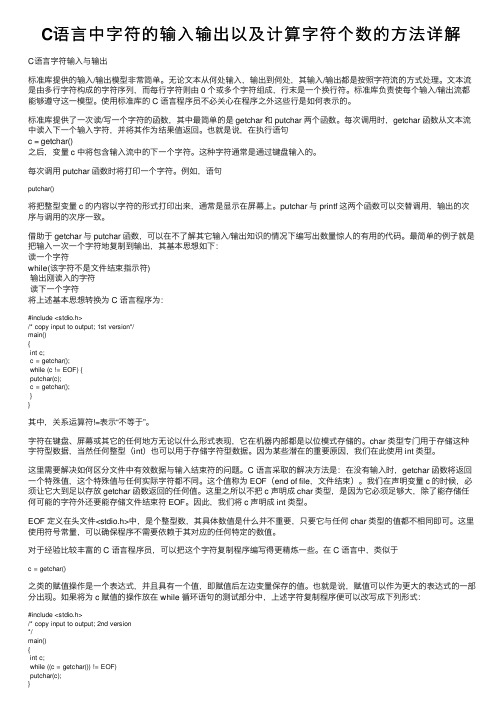
C语⾔中字符的输⼊输出以及计算字符个数的⽅法详解C语⾔字符输⼊与输出标准库提供的输⼊/输出模型⾮常简单。
⽆论⽂本从何处输⼊,输出到何处,其输⼊/输出都是按照字符流的⽅式处理。
⽂本流是由多⾏字符构成的字符序列,⽽每⾏字符则由 0 个或多个字符组成,⾏末是⼀个换⾏符。
标准库负责使每个输⼊/输出流都能够遵守这⼀模型。
使⽤标准库的 C 语⾔程序员不必关⼼在程序之外这些⾏是如何表⽰的。
标准库提供了⼀次读/写⼀个字符的函数,其中最简单的是 getchar 和 putchar 两个函数。
每次调⽤时,getchar 函数从⽂本流中读⼊下⼀个输⼊字符,并将其作为结果值返回。
也就是说,在执⾏语句c = getchar()之后,变量 c 中将包含输⼊流中的下⼀个字符。
这种字符通常是通过键盘输⼊的。
每次调⽤ putchar 函数时将打印⼀个字符。
例如,语句putchar()将把整型变量 c 的内容以字符的形式打印出来,通常是显⽰在屏幕上。
putchar 与 printf 这两个函数可以交替调⽤,输出的次序与调⽤的次序⼀致。
借助于 getchar 与 putchar 函数,可以在不了解其它输⼊/输出知识的情况下编写出数量惊⼈的有⽤的代码。
最简单的例⼦就是把输⼊⼀次⼀个字符地复制到输出,其基本思想如下:读⼀个字符while(该字符不是⽂件结束指⽰符)输出刚读⼊的字符读下⼀个字符将上述基本思想转换为 C 语⾔程序为:#include <stdio.h>/* copy input to output; 1st version*/main(){int c;c = getchar();while (c != EOF) {putchar(c);c = getchar();}}其中,关系运算符!=表⽰“不等于”。
字符在键盘、屏幕或其它的任何地⽅⽆论以什么形式表现,它在机器内部都是以位模式存储的。
char 类型专门⽤于存储这种字符型数据,当然任何整型(int)也可以⽤于存储字符型数据。
c语言char的用法
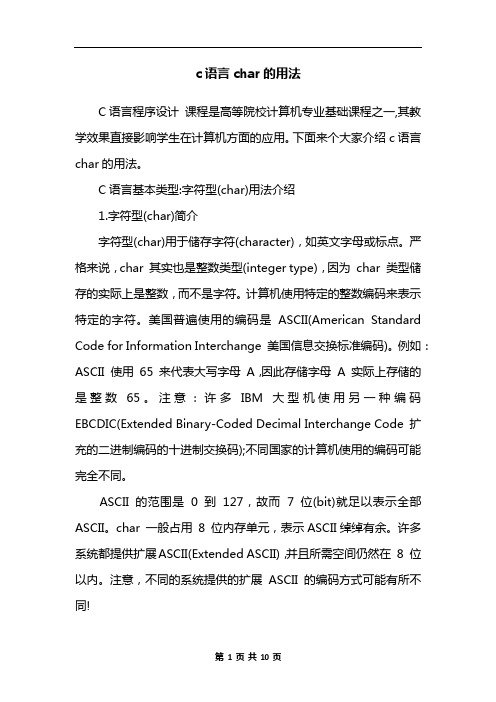
c语言char的用法C语言程序设计课程是高等院校计算机专业基础课程之一,其教学效果直接影响学生在计算机方面的应用。
下面来个大家介绍c语言char的用法。
C语言基本类型:字符型(char)用法介绍1.字符型(char)简介字符型(char)用于储存字符(character),如英文字母或标点。
严格来说,char 其实也是整数类型(integer type),因为char 类型储存的实际上是整数,而不是字符。
计算机使用特定的整数编码来表示特定的字符。
美国普遍使用的编码是ASCII(American Standard Code for Information Interchange 美国信息交换标准编码)。
例如:ASCII 使用65 来代表大写字母A,因此存储字母A 实际上存储的是整数65。
注意:许多IBM大型机使用另一种编码EBCDIC(Extended Binary-Coded Decimal Interchange Code 扩充的二进制编码的十进制交换码);不同国家的计算机使用的编码可能完全不同。
ASCII 的范围是0 到127,故而7 位(bit)就足以表示全部ASCII。
char 一般占用8 位内存单元,表示ASCII绰绰有余。
许多系统都提供扩展ASCII(Extended ASCII),并且所需空间仍然在8 位以内。
注意,不同的系统提供的扩展ASCII 的编码方式可能有所不同!许多字符集超出了8 位所能表示的范围(例如汉字字符集),使用这种字符集作为基本字符集的系统中,char 可能是16 位的,甚至可能是32 位的。
总之,C 保证char 占用空间的大小足以储存系统所用的基本字符集的编码。
C 语言定义一个字节(byte)的位数为char 的位数,所以一个字节可能是16 位,也可能是32 位,而不仅仅限于8 位。
2. 声明字符型变量字符型变量的声明方式和其它类型变量的声明方式一样:char good;char better, best;以上代码声明了三个字符型变量:good、better,和best。
第三章 C语言数据的输入与输出复习

l L
从上表可知:双精度实型数据的输出不要用%lf, 只要用%f即可。但长双精度实型数据的输出必须加 长度修饰符L, 例如%Lf、%Le等。
格式化输出函数printf()
printf函数的输出格式说明
每个格式说明都必须用%开头,以一个格式字
符作为结束,在此之间根据需要可以插入"宽度说
明"、长度修饰符'l'和'L"等。
(1)格式字符:格式字符用于规定输出不同的数据 类型,格式字符和它们的作用如下表,可详见附录 D。
格式化输出函数printf()
scanf函数的功能是从标准输入流中按指定格式 接收输入的数据; scanf函数的调用格式为: scanf(格式控制字符串, 地址列表);
格式控制字符串同printf
地址列表是由若干个地址组成的表列,可以是变 量的地址,或字符串的首地址
格式化输入函数scanf()
例:用scanf函数输入数据 #include "stdio.h" a在内存中的地 main() 址 &是地址运算符 {int a,b,c; scanf("%d%d%d",&a,&b,&c); printf("%d,%d,%d\nf",a,b,c); } 运行情况: 3 4 5<回车> (输入a,b,c的值) 3 ,4 ,5 (输出a,b,c的值)
C语言数据的输入与输出
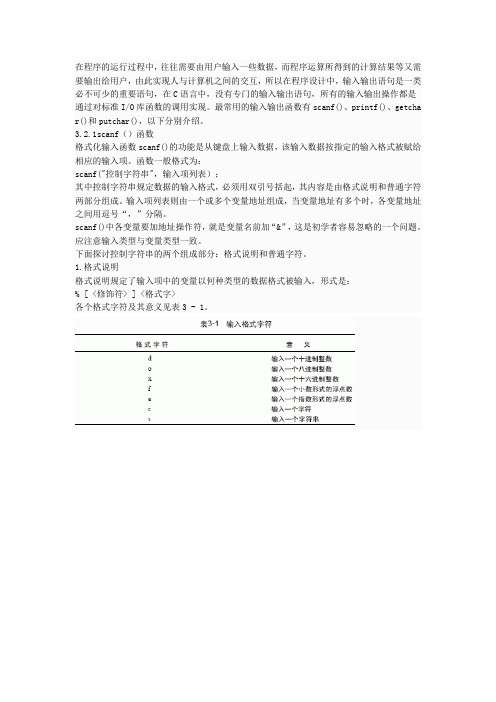
在程序的运行过程中,往往需要由用户输入一些数据,而程序运算所得到的计算结果等又需要输出给用户,由此实现人与计算机之间的交互,所以在程序设计中,输入输出语句是一类必不可少的重要语句,在C语言中,没有专门的输入输出语句,所有的输入输出操作都是通过对标准I/O库函数的调用实现。
最常用的输入输出函数有scanf()、printf()、getcha r()和putchar(),以下分别介绍。
3.2.1scanf()函数格式化输入函数scanf()的功能是从键盘上输入数据,该输入数据按指定的输入格式被赋给相应的输入项。
函数一般格式为:scanf("控制字符串",输入项列表);其中控制字符串规定数据的输入格式,必须用双引号括起,其内容是由格式说明和普通字符两部分组成。
输入项列表则由一个或多个变量地址组成,当变量地址有多个时,各变量地址之间用逗号“,”分隔。
scanf()中各变量要加地址操作符,就是变量名前加“&”,这是初学者容易忽略的一个问题。
应注意输入类型与变量类型一致。
下面探讨控制字符串的两个组成部分:格式说明和普通字符。
1.格式说明格式说明规定了输入项中的变量以何种类型的数据格式被输入,形式是:% [ <修饰符> ] <格式字>各个格式字符及其意义见表3 - 1。
3.2.2printf()函数与格式化输入函数scanf()相对应的是格式化输出函数printf(),其功能为按控制字符串规定的格式,向缺省输出设备(一般为显示器)输出在输出项列表中列出的各输出项,其基本格式为:printf(“控制字符串”,输出项列表)输出项可以是常量、变量、表达式,其类型与个数必须与控制字符串中格式字符的类型、个数一致、当有多个输出项时,各项之间用逗号分隔。
控制字符串必须用双引号括起,由格式说明和普通字符两部分组成。
1.格式说明一般格式为:%[<修饰符>]<格式字符>格式字符规定了对应输出项的输出格式,常用格式字符见表3-2。
《c语言程序设计教学资料》第4章---键盘输入与屏幕输出

编辑ppt
编辑ppt
格式化输出
例: m.n 例:int a=1234; float f=123.456; char ch=‘a’; printf(“%8d\n%2d\n”,a,a); printf(“%f\n%8f\n%8.1f\n%.2f\n%.2e\n”,f,f,f,f,f); printf(“%3c\n”,ch);
float f=123.456; printf(“%f\n%10f\n%10.2f\n%.2f\n%-10.2f\n”,f,f,f,f ,f ); }
编辑ppt
%e格式符
指定以指数形式输出实数 VC++给出小数位数为6位
指数部分占5列 小数点前必须有而且只有1位非零数字 printf(”%e”,123.456); 输出:1.234560 e+002
补空格。
编辑ppt
输出实数时的有效位数。
#include <stdio.h> void main() { float x,y;
x=111111.111; y=222222.222; printf(″%f″,x+y); }
编辑ppt
例4.8 输出实数时指定小数位数。
#include <stdio.h> void main() {
有以下几种用法:
① %f。不指定字段宽度,由系统自动指定字段宽度,使整数
部分全部输出,并输出6位小数。应当注意,在输出的数字中
并非全部数字都是有效数字。单精度实数的有效位数一般为7位。
②%m.nf。指定输出的数据共占m列,其中有n位小数。如果
键盘输入与屏幕输出-3单个字符的输入和输出

第3章键盘输入与屏幕输出——单个字符的输入和输出哈尔滨工业大学苏小红本节要讨论的主要问题⏹用getchar()从键盘输入单个字符⏹用putchar()向屏幕输出单个字符字符常量⏹字符常量是用单引号括起来的一个字符'3'表示一个数字字符,而3则表示一个整数数值⏹转义字符(Escape Character)一些特殊字符(无法从键盘输入或者另有他用) 所有的ASCII码都可以通过转义方式表示出来字符在内存中是如何存储的?对应的ASCII码的二进制值‘B'的ASCII码值是十进制——66八进制——0102十六进制——0x42所有的ASCII码都可通过转义方式表示'B''\102''\x42'字符型变量⏹定义一个字符型变量char ch;⏹字符型变量的值单个字符的输入输出⏹字符输出函数putchar()putchar(ch)向屏幕输出一个字符,字符型变量ch的值⏹字符输入函数getchar()ch = getchar()从键盘接收的字符作为getchar()的函数值无参数大写英文字母转换成小写英文字母小写英文字母转换成大写英文字母ch = ch - 32;大写英文字母转换成小写英文字母大写英文字母转换成小写英文字母两种输入输出方法的比较⏹输入字符的两种方法ch = getchar();scanf("%c", &ch);⏹输出字符的两种方法putchar(ch);printf("%c", ch);讨论。
C语言中字符串详解

C语⾔中字符串详解C语⾔中字符串详解字符串时是C语⾔中⾮常重要的部分,我们从字符串的性质和字符串的创建、程序中字符串的输⼊输出和字符串的操作来对字符串进⾏详细的解析。
什么是字符串?C语⾔本⾝没有内置的字符串类型,字符串本质上是⼀种特殊类型的数组,它的组成元素类型为char,除此之外不受制与数组长度的限制,以'\0'作为结束标志,作为字符串结束的标志。
(\0作为⼀个特殊字符,它的ASCII值为0,但是它不是'0'字符,'0'字符的ASCII值为48。
)定义字符串1. 字符串字⾯量(字符串常量)字符串字⾯量形如"string",也被称为字符串常量,编译器会将它末尾⾃动添加上字符串结尾标志\0。
它作为⼀种静态存储类型,在程序开始运⾏时被分配地址,⼀直存在到程序结束,引号括起来的部分将表⽰它储存的⾸地址,很类似于数组,数组名作为数组⾸元素储存的地址。
#include <stdio.h>int main() {printf("%s %p %c", "Hello", "Hello", *"Hello");return 0;}/*** Hello 00405044 H* **/上⾯说明了字符串常量的储存形式,⽽且它本⾝只代表⾸元素的地址。
2. 字符串数组形式的初始化字符串以⼀种特殊的字符串数组的形式存在,区别于⼀般数组,进⾏⼀般初始化时:char a[] = {'h', 'e', 'l', 'l', 'o', '!', '\0'};⽽不能是:char a[] = {'h', 'e', 'l', 'l', 'o', '!'};后者仍然是⼀个普通的字符串数组,不是字符串,这样的初始化显然是⿇烦的,我们可以这样:char a[] = "hello!";或者char *a = "hello!";怎么理解这两种⾏为呢,他们都使⽤a储存了字符串hello!的地址,但是它们也是有所不同的,下⾯详细讨论下他们的区别所在。
字符输入输出函数的使用

字符输入输出函数的使用字符输入输出函数的使用在计算机编程中,字符输入输出函数是我们常常需要使用的一类函数。
这类函数主要用于在程序中输出一些字符或者从输入流中读取一些字符,并将其作为程序的输入或输出。
一、字符输出函数1. putchar()putchar() 函数可以将一个字符输出到标准输出流 stdout 中。
其使用方式为:putchar(c),其中 c 为一个字符。
例如,下面的代码可以将字符 'A' 输出到屏幕上:```#include <stdio.h>int main(){putchar('A');return 0;}```2. puts()puts() 函数可以将一个字符串输出到标准输出流 stdout 中。
其使用方式为:puts(str),其中 str 为一个字符串。
例如,下面的代码可以将字符串 "Hello, world!" 输出到屏幕上:```#include <stdio.h>int main(){puts("Hello, world!");return 0;}```二、字符输入函数1. getchar()getchar() 函数可以从标准输入流 stdin 中读取一个字符,并将其返回。
其使用方式为:getchar()。
例如,下面的代码可以从键盘上读取一个字符,并将其输出到屏幕上:```#include <stdio.h>int main(){char c = getchar();putchar(c);return 0;}```2. gets()gets() 函数可以从标准输入流 stdin 中读取一行字符串,并将其保存到一个字符数组中。
其使用方式为:gets(str),其中 str 为一个字符数组。
例如,下面的代码可以从键盘上读取一行字符串,并将其输出到屏幕上:```#include <stdio.h>int main(){char str[256];gets(str);puts(str);return 0;}```不过需要注意的是,gets() 函数在读取字符串时没有进行越界检查,如果读取的字符串超过了字符数组的长度,就会发生数组越界访问的错三、格式化输入输出函数格式化输入输出函数可以将指定格式的数据输出到标准输出流 stdout 中,或者从标准输入流 stdin 中读取指定格式的数据。
语言输入和输出 PPT

/* 本程序测试printf()函数得返回值 */
#include<stdio、h>
main(){
int count;
/* 定义count,用来接收返回值 */
float r1 = 12345、12345678, r2 = 123、123456789;
int a; printf("Please input the data: "); scanf(“%d\n”,&a); /* 注意这里加了一个换行符\n */ printf(“%d\n",a); }
问题: 被要求输入两个数才能正常结束
原因: 程序要求输入空白符,而空白符就是数据得定界 符
2、标准输入流中残留字符问题
语言输入和输出
3、1 概述
通过终端输入(如键盘、鼠标等),也称为标准输入(standard input),直接向终端输出(如显示器、打印机等),也称为标准输出 (standard output)。
C语言本身没有提供输入输出语句,C语言中得所有I/O操作都就 是通过函数调用来实现,而这些并非C语言一部分得输入输出函数均 以目标级程序得方式提供,并存放在一个C标准函数库中。
#include<stdio、h> 或
#include"stdio、h"
3、2 字符输入输出函数
3、2、1 字符输出函数putchar()
putchar()函数就是向屏幕一个字符, 其调用格式为:
putchar(ch);
其中ch为一个字符变量、字符常量或整型常量。
/* 本程序测试多种类型数据作putchar()函数参数得输出情况 */
- 1、下载文档前请自行甄别文档内容的完整性,平台不提供额外的编辑、内容补充、找答案等附加服务。
- 2、"仅部分预览"的文档,不可在线预览部分如存在完整性等问题,可反馈申请退款(可完整预览的文档不适用该条件!)。
- 3、如文档侵犯您的权益,请联系客服反馈,我们会尽快为您处理(人工客服工作时间:9:00-18:30)。
一个统计字数的程序
Enter text (| to quit): Reason is a powerful servant but an inadequate master. | characters = 56, words = 9, lines = 3, partial lines = 0
12
4 if c is a white space and inword is true
5
set inword t/ wordcnt.c: #include <stdio.h> #include <ctype.h> #include <stdbool.h> #define STOP ’|’ int main(void) {
3 while there is more input
4
increment character count
5
if a line has been read , increment line
count
6
if a word has been read , increment word
count
7
read next character
char c, prev; long n_chars = 0L; int n_lines = 0, n_words = 0, p_lines = 0; bool inword = false; printf("Enter text (| to quit):\n"); prev = ’\n’; while ((c = getchar()) != STOP) {
n_chars ++; if (c == ’\n’) n_lines ++;
10
一个统计字数的程序 ii
if (!isspace(c) && !inword) { inword = true; n_words ++;
} if (isspace(c) && inword) inword = false; prev = c; } if (prev != ’\n’) p_lines = 1; printf("characters = %ld , words = %d, lines = %d, ", n_chars , n_words , n_lines); printf("partial lines = %d\n", p_lines); return 0; }
4
一个统计字数的程序
// 循环输入结构 while ((ch = getchar()) != STOP) {
... }
5
一个统计字数的程序
// 循环输入结构 while ((ch = getchar()) != STOP) {
... }
在通用的单词统计程序中,换行符和句号都不适合标记一段文字的结 束。我们将采用一个不常见的字符 |。
5
一个统计字数的程序
• 程序使用 getchar() 来循环输入字符,可在每次循环通过递增一 个字符计数器的值来统计字符。
• 为统计行数,程序可检查换行符。若字符为换行符,程序就递 增行数计数器的值。若 STOP 字符出现在一行的中间,则将该行作 为一个不完整行来统计,即该行有字符但没有换行符。
6
C/C++
字符输入输出和字符确认
张晓平
武汉大学数学与统计学院
Table of contents
1. 一个统计字数的程序 2. getchar() 与 putchar() 函数 3. 缓冲区 (Buffer) 4. 终止键盘输入 5. 创建一个更友好的用户界面 6. 输入确认 7. 菜单浏览 8. 上机操作
getchar() 与 putchar() 函数
getchar() 与 putchar() 函数
1 // echo.c:
2 #include <stdio.h>
3 int main(void)
4{
5 char ch;
6 while ((ch = getchar()) != ’#
’)
7
putchar ( ch );
8 return 0;
9}
13
getchar() 与 putchar() 函数
1 // echo.c:
2 #include <stdio.h>
3 int main(void)
4{
5 char ch;
6 while ((ch = getchar()) != ’#
’)
7
putchar ( ch );
8 return 0;
1
一个统计字数的程序
一个统计字数的程序
编制程序,读取一段文字,并报告其中的单词个数,同时统计字符个 数和行数。
2
一个统计字数的程序
• 该程序应该逐个读取字符,并想办法判断何时停止。 • 应该能够识别并统计字符、行和单词。
3
一个统计字数的程序
1 // pseudo code
2 read a character
• 检测空白字符的判断表达式为 c == ’ ’ || c == ’\n’ || c == ’\t’ 或 isspace(c) // #include <ctype.h>
8
一个统计字数的程序
• 为了判断一个字符是否在某个单词中,可在读入一个单词的首字 符时把一个标志 (命名为 inword ) 设置为 1,同时在此处递增单 词个数。
一个统计字数的程序
如何识别单词?
7
一个统计字数的程序
如何识别单词? • 可将一个单词定义为不包含空白字符的一系列字符。 • 一个单词以首次遇到非空白字符开始,在下一个空白字符出现时 结束。
7
一个统计字数的程序
• 检测非空白字符的判断表达式为 c != ’ ’ && c != ’\n’ && c != ’\t’ 或 !isspace(c) // #include <ctype.h>
9}
Hello world Hello world I am happy I am happy
• 只要 inword 为 1,后续的非空白字符就不标记为一个单词的开 始。到出现下一个空白字符时,就把 inword 设置为 0。
1 // pseudo code
2 if c is not a whitespace and inword is false
3
set inword to true and count the word
